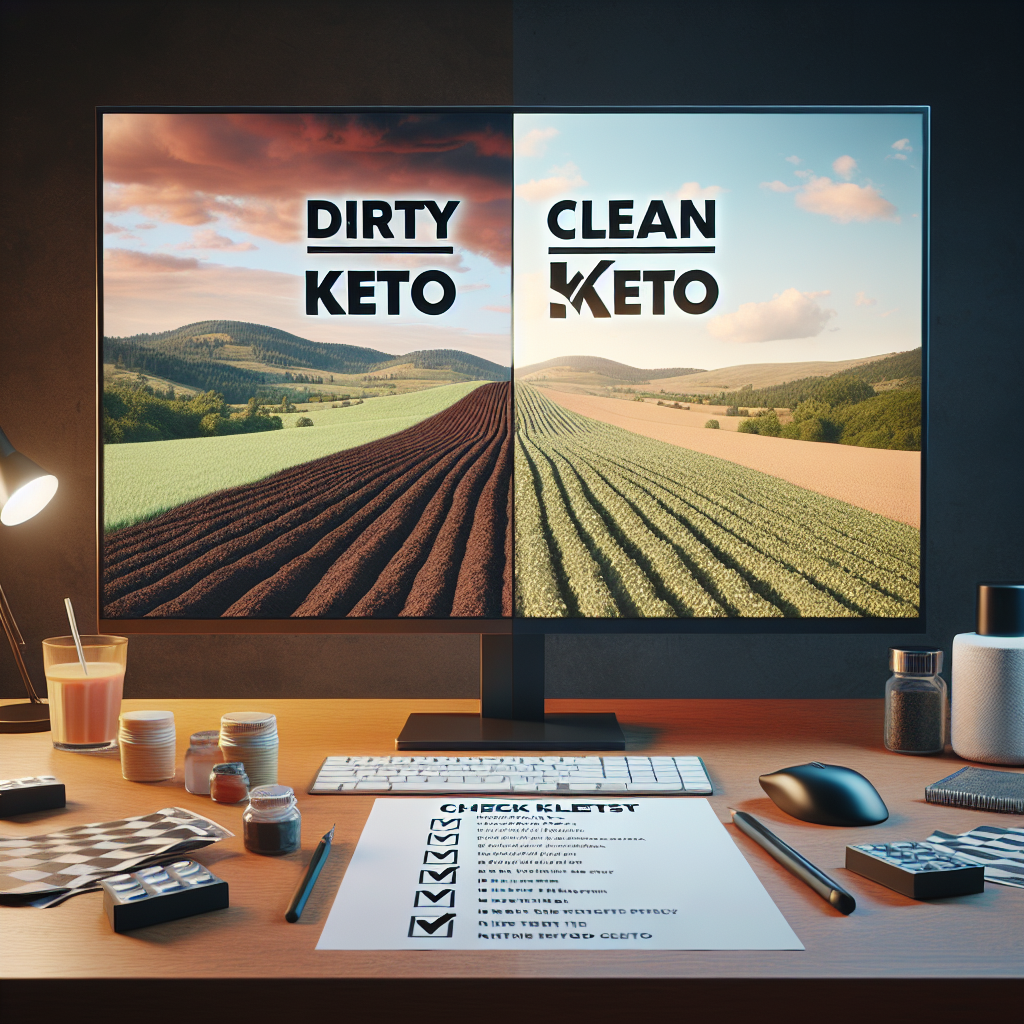
-
Table of Contents
- Dirty Keto vs Clean Keto Checklist: Which One are You?
- Understanding the Basics of the Keto Diet
- What is Clean Keto?
- What is Dirty Keto?
- Comparing Clean and Dirty Keto: Pros and Cons
- Benefits of Clean Keto
- Drawbacks of Clean Keto
- Benefits of Dirty Keto
- Drawbacks of Dirty Keto
- Conclusion: Which Keto is Right for You?
Dirty Keto vs Clean Keto Checklist: Which One are You?

The ketogenic diet, or keto for short, has gained significant popularity in recent years. This low-carb, high-fat diet is praised for its ability to promote weight loss, improve mental clarity, and boost overall health. However, not all keto diets are created equal. In this article, we will delve into the differences between “dirty” and “clean” keto, providing you with a comprehensive checklist to help you identify which one you’re following. We’ll also explore the potential benefits and drawbacks of each approach.
Understanding the Basics of the Keto Diet
The ketogenic diet is a low-carb, high-fat diet that aims to shift your body’s metabolism from burning glucose (sugar) for energy to burning ketones, which are produced when your body breaks down fat. This metabolic state, known as ketosis, can lead to rapid weight loss.
However, the type of foods you eat to achieve ketosis can vary greatly, leading to the distinction between clean and dirty keto. Let’s take a closer look at what these terms mean.
What is Clean Keto?
Clean keto, also known as strict or traditional keto, focuses on consuming whole, nutrient-dense foods. It emphasizes healthy fats, moderate amounts of high-quality protein, and minimal carbohydrates. The goal is not only to enter ketosis but also to nourish your body with nutrient-rich foods.
Here’s a basic checklist for clean keto:
- 70-75% of your daily calories come from healthy fats (e.g., avocados, olive oil, nuts, and seeds)
- 20-25% come from high-quality proteins (e.g., grass-fed beef, wild-caught fish, free-range eggs)
- 5-10% come from carbohydrates, primarily non-starchy vegetables and low-sugar fruits
- Avoidance of processed foods, artificial sweeteners, and unhealthy fats
What is Dirty Keto?
Dirty keto follows the same macronutrient breakdown as clean keto, but it doesn’t focus on the quality of the foods. As long as the food fits within the macronutrient ratios, it’s considered acceptable. This means processed foods, fast food, and artificial sweeteners are all fair game.
Here’s a basic checklist for dirty keto:
- 70-75% of your daily calories come from any type of fats (e.g., cheese, bacon, fast food)
- 20-25% come from any source of protein (e.g., processed meats, fast food burgers without the bun)
- 5-10% come from any carbohydrates, including those from processed foods
- Food quality and nutrient density are not a primary concern
Comparing Clean and Dirty Keto: Pros and Cons
Both clean and dirty keto can lead to weight loss due to the metabolic shift to ketosis. However, the long-term health implications can vary significantly.
Benefits of Clean Keto
Clean keto promotes overall health and well-being. By focusing on nutrient-dense foods, you’re not only promoting weight loss but also nourishing your body with essential vitamins, minerals, and antioxidants. This can lead to improved energy levels, better mental clarity, and a reduced risk of chronic diseases.
Drawbacks of Clean Keto
The main drawback of clean keto is that it requires more time, effort, and potentially money. Planning, preparing, and cooking whole foods can be time-consuming, and high-quality proteins and fats can be more expensive than their processed counterparts.
Benefits of Dirty Keto
The primary benefit of dirty keto is convenience. It’s easier to grab a fast-food burger (without the bun) or a bag of pork rinds than it is to prepare a salad with grilled chicken and homemade dressing. For those with a busy lifestyle, dirty keto can make adhering to a low-carb diet more feasible.
Drawbacks of Dirty Keto
While dirty keto may promote weight loss, it can also lead to nutrient deficiencies and long-term health problems. Processed foods are often high in unhealthy fats, sodium, and artificial ingredients, which can increase your risk of heart disease, high blood pressure, and other health issues.
Conclusion: Which Keto is Right for You?
Whether clean or dirty keto is right for you depends on your individual goals, lifestyle, and health status. If you’re primarily focused on weight loss and need a convenient option, dirty keto may be a good fit. However, if you’re looking to improve your overall health and are willing to invest more time and effort into your diet, clean keto is the way to go.
Remember, the best diet is one that you can stick to long-term and that makes you feel good both physically and mentally. Always consult with a healthcare professional before starting any new diet plan.